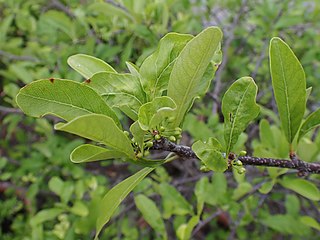Ironwood is a common name for many woods or plants that have a reputation for hardness, or specifically a wood density that is heavier than water, although usage of the name ironwood in English may or may not indicate a tree that yields such heavy wood.

Charpentiera elliptica, the ellipticleaf pāpala, is an endangered species of flowering tree in the family Amaranthaceae, endemic to the island of Kauaʻi in Hawaiʻi. It inhabits coastal mesic and mixed mesic forests at elevations of 250–1,250 metres (820–4,100 ft). It is a perennial tree, growing up to 20 ft (6.1 m).

Sideroxylon is a genus of trees in the family Sapotaceae described as a genus by Linnaeus in 1753. They are collectively known as bully trees. The generic name is derived from the Greek words σιδηρος (sideros), meaning "iron", and ξύλον (xylon), meaning "wood."

Prosopis glandulosa, commonly known as honey mesquite, is a species of small to medium-sized, thorny shrub or tree in the legume family (Fabaceae).

Sideroxylon reclinatum, the Florida bully, is a small tree in the family Sapotaceae. It occurs locally in the southeastern United States.

Sideroxylon lanuginosum is a shrub or small tree of the family Sapotaceae. It is native to the Sun Belt and Midwest of the United States as well as Northeastern Mexico. Common names include gum bully, black haw, chittamwood, chittimwood, shittamwood, false buckthorn, gum bumelia, gum elastic, gum woolybucket, woolybucket bumelia, wooly buckthorn, wooly bumelia, ironwood and coma.
Melicope haleakalae, Haleakala melicope, is a species of plant in the family Rutaceae. It is endemic to the Hawaiian Islands. It is a perennial shrub or tree that grows up to 10 ft (3.0 m) tall. It grows in wet forests.
Sideroxylon socorrense is a plant species in the family Sapotaceae. It is endemic to Mexico, occurring only on Socorro in the Revillagigedo Islands.

Rhamnus cathartica, the European buckthorn, common buckthorn, purging buckthorn, or just buckthorn, is a species of small tree in the flowering plant family Rhamnaceae. It is native to Europe, northwest Africa and western Asia, from the central British Isles south to Morocco, and east to Kyrgyzstan. It was introduced to North America as an ornamental shrub in the early 19th century or perhaps before, and is now naturalized in the northern half of the continent, and is classified as an invasive plant in several US states and in Ontario, Canada.
Sideroxylon salicifolium, commonly called white bully or willow bustic, is a species of flowering plant native to Florida, the West Indies and Central America.

Sideroxylon celastrinum is a species of flowering plant in the family Sapotaceae, that is native to Texas and Florida in the United States south through Central America to northern Venezuela and Colombia in South America. Common names include saffron plum and coma. It is a spiny shrub or small tree that reaches a height of 2–9 m (6.6–29.5 ft). The dark green leaves are alternate or fascicled at the nodes and oblanceolate to obovate. Greenish-white flowers are present from May to November and are followed by single-seeded, blue-black drupes.

Sideroxylon foetidissimum, commonly known as false mastic or yellow mastic, is a species of flowering plant in the family Sapotaceae. It is native to Florida in the United States, the Caribbean, and northern Central America.

Frangula caroliniana, commonly called the Carolina buckthorn, is a deciduous upright shrub or small tree native to the southeastern, south-central, and mid-western parts of the United States, from Texas east to Florida and north as far as Maryland, Ohio, Missouri, and Oklahoma. There is also an isolated population in the State of Nuevo León in northeastern Mexico. It is found in a wide variety of habitats, including barrens, forests, and limestone bluffs.

Quercus chapmanii, commonly referred to as the Chapman oak, is a species of oak that grows in the southeastern United States.

Rhamnus alnifolia is a species of flowering plant in the buckthorn family known by the common names alderleaf buckthorn, or alder buckthorn. Unlike other "buckthorns", this alder buckthorn does not have thorns. It is native to North America, where it is known mainly from the southern half of Canada and the northern half of the United States and California. It can be found in forested habitat.

Prunus caroliniana, known as the Carolina laurelcherry, Carolina cherry laurel, Carolina cherry, or Cherry laurel, is a small evergreen flowering tree native to the lowlands of Southeastern United States, from North Carolina south to Florida and westward to central Texas. The species also has escaped into the wild in a few places in California.

Quercus grisea, commonly known as the gray oak, shin oak or scrub oak, is a North American species deciduous or evergreen shrub or medium-sized tree in the white oak group. It is native to the mountains of the southwestern United States and northern Mexico. It hybridises with four other oak species where the ranges overlap, the Arizona white oak (Q. arizonica), the Gambel oak (Q. gambelii), the Mohr oak (Q. mohriana) and the sandpaper oak (Q. pungens).

Rhamnus lycioides, the black hawthorn, European buckthorn, or Mediterranean buckthorn, is a shrub up to about 1 metre tall in the buckthorn family, Rhamnaceae. It is found in the Mediterranean region, in southern Europe and northern Africa. Its scientific name lycioides refers to its resemblance to the botanical genus Lycium.
Sideroxylon alachuense, known by the common names Alachua bully, silver bully and silvery buckthorn, is a plant species native to the US states of Georgia and Florida. It grows in forested areas on hummocks, or near lime sinks or shell middens, at elevations of less than 200 m.

Sideroxylon tenax, called the tough bully, is a plant species native to Florida, Georgia, South Carolina and the southernmost part of North Carolina. It grows on dry, sandy soil in pine forests, pine-oak woodlands, and hummocks at elevations less than 100 m.

















